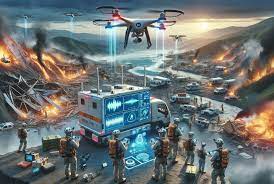I. Introduction
In the face of natural disasters, swift and efficient responses are paramount to saving lives and minimizing damage. The integration of technology into disaster relief efforts has revolutionized the way organizations and responders tackle these crises. This article explores how technology is driving faster, smarter responses in the field of disaster relief.
II. Early Challenges in Traditional Disaster Response
a. Historical Limitations
- Communication Hurdles: Limited communication infrastructure hindered effective coordination between response teams.
- Data Collection Delays: Gathering crucial data on affected areas was time-consuming, slowing down decision-making processes.
b. Resource Allocation Difficulties
- Manual Processes: Allocating resources manually often resulted in delays and inefficiencies.
- Logistical Challenges: Navigating affected areas and delivering aid posed significant logistical challenges.
III. Technological Innovations Transforming Disaster Response
a. Real-Time Data Analysis
- Satellite Imaging: Satellite technology provides real-time imagery, aiding in damage assessment and resource allocation.
- Drones for Surveillance: Unmanned aerial vehicles (UAVs) enable quick, detailed surveillance of disaster-stricken areas.
b. Advanced Communication Systems
- Mobile Connectivity: Enhanced mobile networks and satellite communication systems improve connectivity in remote areas.
- IoT Devices: Internet of Things (IoT) devices provide real-time data on environmental conditions and infrastructure status.
IV. Artificial Intelligence (AI) and Predictive Analytics
a. Early Warning Systems
- Predictive Modeling: AI algorithms analyze historical data to predict potential disaster events, allowing for early warnings.
- Automated Alerts: Automated alert systems notify communities and authorities about impending disasters in real-time.
b. Resource Optimization with AI
- Smart Resource Allocation: AI-driven systems optimize the distribution of resources based on real-time needs.
- Traffic Management: Predictive analytics help manage traffic for smoother evacuation and response operations.
V. Enhanced Search and Rescue Operations
a. Robotics in Disaster Zones
- Robotic Devices: Search and rescue robots navigate hazardous areas, locating survivors and assessing structural integrity.
- Autonomous Vehicles: Drones and ground-based vehicles equipped with AI assist in locating and rescuing individuals.
b. Wearable Technologies
- Health Monitoring: Wearables track vital signs of responders and survivors, ensuring timely medical interventions.
- GPS Tracking: Locating individuals in disaster-stricken areas is facilitated through wearable GPS devices.
VI. Community Engagement and Social Media Integration
a. Crowdsourced Data
- Social Media Monitoring: Analyzing social media data provides real-time insights into the needs and conditions of affected communities.
- Crowdsourced Mapping: Platforms like OpenStreetMap enable the crowd to contribute to mapping affected areas for better coordination.
b. Communication through Apps
- Emergency Apps: Mobile applications provide real-time information, emergency contacts, and communication channels for affected communities.
- Two-Way Communication: Apps enable two-way communication between responders and affected individuals for more effective assistance.
VII. Challenges and Ethical Considerations
a. Data Privacy Concerns
- Sensitive Information Handling: Balancing the need for information with respecting privacy during disaster response efforts.
- Ethical Use of AI: Ensuring AI technologies are ethically employed, especially in decision-making processes.
b. Integration Challenges
- Interoperability: Ensuring seamless integration between different technologies and systems used in disaster relief.
- Training and Adoption: Adequate training for responders and communities to maximize the benefits of new technologies.
VIII. Conclusion
Technology has emerged as a powerful ally in disaster relief efforts, significantly improving response times and effectiveness. From real-time data analysis to AI-driven resource allocation, these innovations are reshaping the landscape of disaster response. As we navigate the future, it is crucial to address challenges and ethical considerations to ensure that technology continues to play a positive and impactful role in disaster relief.
FAQs
- Q: How does technology enhance early warning systems in disaster response?
- A: Technology, including AI and predictive modeling, enables early warning systems by analyzing historical data to predict and notify about potential disasters in real-time.
- Q: What role do robotics play in disaster zones for search and rescue operations?
- A: Robotics, such as search and rescue robots and autonomous vehicles, assist in navigating hazardous areas, locating survivors, and assessing structural integrity.
- Q: How is crowdsourced data utilized in disaster response?
- A: Crowdsourced data, gathered through social media monitoring and mapping platforms, provides real-time insights into the needs and conditions of affected communities, aiding in better coordination.
- Q: What challenges and ethical considerations arise in the integration of technology in disaster relief?
- A: Challenges include data privacy concerns, ensuring ethical use of AI, interoperability between different technologies, and the need for training and adoption among responders and communities.

